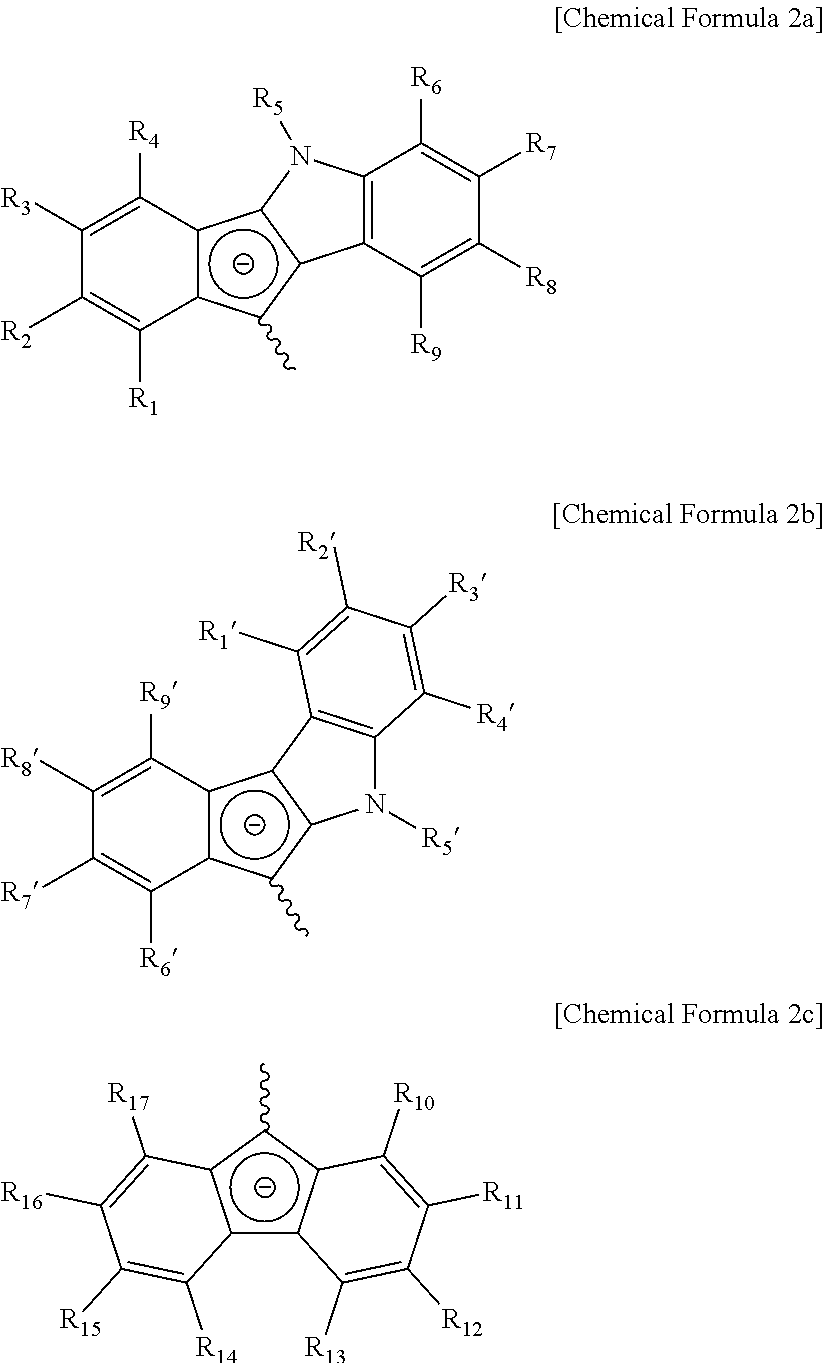Method for preparing polyolefin and polyolefin prepared thereby
a technology of polyolefin and polyolefin, which is applied in the field of preparing polyolefin and polyolefin prepared thereby, can solve the problems of degradation of processibility of polyolefin prepared using a metallocene catalyst, the inability to adequately exhibit the excellent properties of ultra high molecular weight polyolefin, and the inability to secure desired properties. , to achieve the effect of effective preparation, good stress crack resistance and good
- Summary
- Abstract
- Description
- Claims
- Application Information
AI Technical Summary
Benefits of technology
Problems solved by technology
Method used
Image
Examples
synthesis example 1
[0147]
[0148]1-1 Preparation of a Ligand Compound
[0149]2 g of fluorene was dissolved in 5 mL MTBE, 100 mL hexane, 5.5 mL of n-BuLi, 2.5 M solution in hexane was added dropwise in a dry ice / acetone bath, and the solution was stirred at room temperature overnight. 3.6 g of (6-(tert-butoxy)hexyl)dichloro(methyl)silane was dissolved in 50 mL of hexane, the fluorene-Li slurry was transferred thereto for 30 minutes under a dry ice / acetone bath, and the solution was stirred at room temperature overnight. Simultaneously, 5,8-dimethyl-5,10-dihydroindeno[1,2-b]indole (12 mmol, 2.8 g) was also dissolved in 60 mL of THF, 5.5 mL of n-BuLi, 2.5 M solution in hexane was added dropwise in a dry ice / acetone bath, and the solution was stirred at room temperature overnight. The reaction solution of fluorene and (6-(tert-butoxy)hexyl)dichloro(methyl)silane was NMR-sampled to confirm the completion of the reaction, and then, the 5,8-dimethyl-5,10-dihydroindeno[1,2-b]indole-Li solution was transferred the...
synthesis example 2
Preparation of (tBu-O—(CH2)6)(CH3)Si(C5(CH3)4)(tBu-N)TiCl2
[0154]50 g of Mg(s) was added to a 10 L reactor at room temperature, and then, 300 mL of THF was added thereto. About 0.5 g of 12 was added, and then, the temperature of the reactor was maintained at 50° C. After the temperature of the reactor was stabilized, 250 g of 6-t-buthoxyhexyl chloride was added to the reactor at a speed of 5 mL / min using a feeding pump. It was observed that as 6-t-buthoxyhexyl chloride was added, the temperature of the reactor increased by about 4 to 5° C. While 6-t-buthoxyhexyl chloride was continuously added, the solution was stirred for 12 hours. After the reaction for 12 hours, a black reaction solution was obtained. 2 mL of the produced black solution was taken, water was added to obtain an organic layer, and 6-t-buthoxyhexane was confirmed by 1H-NMR. It could be seen from the 6-t-buthoxyhexane that a Grignard reaction progressed well. Thus, 6-t-buthoxyhexyl magnesium chloride was synthesized.
[...
synthesis example 3
Preparation of (tert-Bu-O—(CH2)6)MeSi(9-C13H10)2ZrCl2
[0160]1.0 mole of a tert-Bu-O—(CH2)6MgCl solution, a Grignard reagent, was obtained by the reaction of a tert-Bu-O—(CH2)6Cl compound and Mg(O) under THF solvent. The prepared Grignard reagent was added to a flask containing−30° C. MeSiC13 compound (176.1 mL, 1.5 mol) and THF (2.0 mL), the solution was stirred at room temperature for 8 hours or more, and the, the filtered solution was vacuum dried to obtain a tert-Bu-O—(CH2)6SiMeCl2 (yield 92%).
[0161]Fluorene (3.33 g, 20 mmol), hexane (100 mL) and MTBE (methyl tert-butyl ether, 1.2 mL, 10 mmol) were introduced in a reactor at −20° C., 8 mL of n-BuLi (2.5M in Hexane) was slowly added, and the solution was stirred at room temperature for 6 hours. After the stirring was completed, the reactor was cooled to −30° C., and the prepared fluorenyl lithium solution was slowly added to a tert-Bu-O—(CH2)6SiMeCl2 solution (2.7 g, 10 mmol) in hexane (100 mL) at −30° C. over 1 hour. After stirri...
PUM
| Property | Measurement | Unit |
|---|---|---|
| temperature | aaaaa | aaaaa |
| temperature | aaaaa | aaaaa |
| temperature | aaaaa | aaaaa |
Abstract
Description
Claims
Application Information
 Login to View More
Login to View More - R&D
- Intellectual Property
- Life Sciences
- Materials
- Tech Scout
- Unparalleled Data Quality
- Higher Quality Content
- 60% Fewer Hallucinations
Browse by: Latest US Patents, China's latest patents, Technical Efficacy Thesaurus, Application Domain, Technology Topic, Popular Technical Reports.
© 2025 PatSnap. All rights reserved.Legal|Privacy policy|Modern Slavery Act Transparency Statement|Sitemap|About US| Contact US: help@patsnap.com



